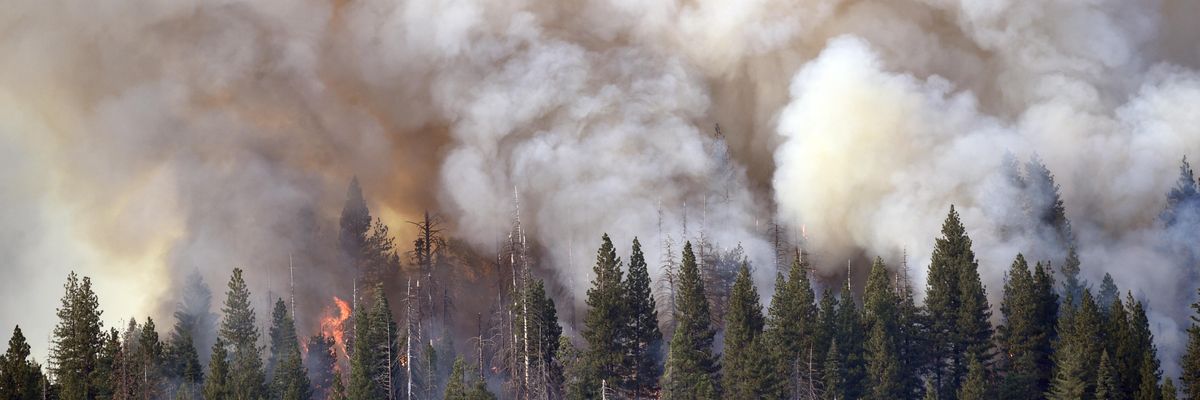Underscoring the need for meaningful action to address the fossil fuel-driven climate crisis, the Washburn Fire that started last week in California's Sierra Nevada mountains has scorched more than 2,300 acres and remains 0% contained as of Monday morning, and the growing blaze is threatening hundreds of ancient sequoias in Yosemite National Park.
In addition to endangering more than 500 mature giant sequoias, the wildfire--burning on the southern end of the park, including in the historic Mariposa Grove--has also put the community of Wawona in jeopardy, prompting evacuation orders and a partial closure of Highway 41. Smoke from the fire is negatively affecting air quality as far away as the Bay Area, located about 200 miles to the west.
Firefighters are bracing for even more challenging conditions this week as hotter and drier weather is expected to pummel an already heatwave- and drought-ravaged region where, according to the National Interagency Fire Center (NIFC), "tree mortality from 2013 to 2015 has left significant dead standing and dead fallen fuels."
The Los Angeles Times reported Sunday:
More than 545 firefighters were battling the blaze in a coordinated land and air attack, officials said. But [U.S. Forest Service spokesperson Stanley] Bercovitz said that thousands more from across the country are being called in. In the case of major fires with valuable assets at risk, such as homes or ancient groves, reinforcements typically are summoned from Oregon and Washington before their fire season has started and from Alaska, Arizona, and New Mexico after their fires begin to die down. But because fire seasons everywhere are lasting longer, he said, it's getting more difficulty to secure help.
There are currently 61 active conflagrations raging in eight states, including 48 in Alaska, where nearly two million acres have been torched in recent weeks. So far in 2022, more than 35,200 wildfires have burned nearly 4.7 million acres, which "continues to be well above average for both wildfires and acres burned," the NIFC said.
"It's turning into a logistical nightmare to get people to work for a long season," said Bercovitz. "But the orders are out now and it's just a matter of getting the resources."
According to CBS News, the Washburn Fire "is so intense it's creating its own weather system and causing updrafts powerful enough to launch debris up into the air."
"Crews are making their way throughout the area, tasked with strategically planning containment lines to save hundreds of iconic sequoias," the outlet reported.
One firefighter, standing in front of the Grizzly Giant, which he called "arguably one of the most famous trees on Earth," explained how his team set up a sprinkler system around the over 200-foot-tall tree to give it "preventative first aid." Crews are also removing dry vegetation from the ground near the trees, some of which are more than 2,000 years old, in a bid to slow the fire's spread and limit potential damage.
"The fire has entered the grove," Robbie Johnson, a spokesperson for the fire response, told CNN on Sunday night. "But the good news is because of prescribed burns and clearing out material on the ground, it's clear in the Mariposa Grove," where protection efforts have created a "doughnut hole" shield.
As the Los Angeles Times noted:
Last year was a devastating fire season for the sequoias after twin wildfires destroyed about 3,600 of the ancient trees as flames sparked by lightning strikes tore through more than two dozen groves in Northern California, National Park Service officials said.
The loss was stunning and equaled roughly 3% to 5% of the world's sequoia population, officials said in a briefing last year after the KNP Complex and Windy fires. Ancient sequoias, with thick bark and massive canopies, can withstand low-intensity fire, and even need it to reproduce. But the giant trees are no match for intense wildfires fueled by climate change and years of drought.
The cause of the Washburn Fire remains under investigation, but as the New York Times pointed out on Sunday, "experts say that climate change is elevating the risks of wildfires," which are becoming bigger and more destructive across the U.S. West.
"Between 2015 and 2021, more than 85% of the acreage of all giant sequoia groves across the Sierra Nevada burned in wildfires, compared to 25% in the previous century," the newspaper noted.
Ted MacDonald, a researcher with the climate and energy program at Media Matters, compiled a Twitter thread showing that the Monday edition of CBS Mornings and ABC's Good Morning America, along with the Sunday edition of NBC's Today, all referred to anthropogenic global warming as a factor in the Washburn Fire.
"It's pretty rare that all three major networks mention climate change in the early days of reporting on an extreme weather event," MacDonald noted. "As these events become more intense, let's keep pushing them to correctly include the climate context."
Attempts to foreground how unmitigated greenhouse gas pollution is increasing the frequency, duration, and severity of extreme weather--including record-high temperatures and worsening droughts, which litter landscapes with kindling that can turbocharge the spread of flames--is consistent with what experts have long been saying.
"We wouldn't be seeing this giant ramp up in fire activity as fast as it is happening without climate change," Park Williams, a climate scientist at the University of California, Los Angeles, told the New York Times last July as Oregon's Bootleg Fire and dozens of other large fire complexes burned out-of-control. "There's just no way."
More recently, several experts warned The Guardian last week that the climate emergency is creating the conditions for another catastrophic wildfire season this summer and fall, following a record-shattering spring.
"It is dire across the board," said Craig Clements, director of the Wildfire Interdisciplinary Research Center at San Jose State University, referring to California's parched terrain. "We have a lot of accumulation of dead fuels and because of drought it is just going to get worse and worse. We can only expect as we get later in the summer, that the fires will get bigger."



